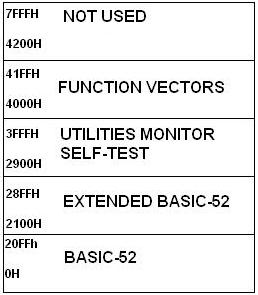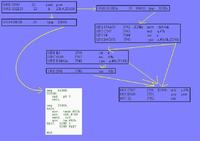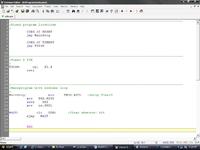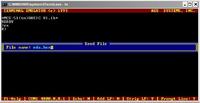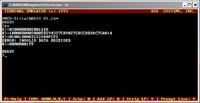umery2k75
Advanced Member level 1

Hi,
I am using AES-51 Computer Embedded Controller from ADVANCED EDUCATIONAL SYSTEMS for designing a project. It is based on 80C32 microcontroller.
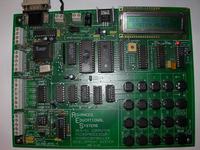
Programs using interrupts are giving me unusual responses.
I made a test program which would generate a 10 KHz square wave on P1.4, now every time I run this program I get the different frequency on P1.4.
Test Program:
=========
org 400BH
TOISR:
cpl p1.4
reti
org 7000h
main:
mov tmod,#02h
mov th0,#-50
setb tr0
mov ie,#82h
sjmp $
end
I’m doing this as:
===========
• I attach RS-232 cable with a computer and attach the DC adaptor of controller in a power socket.
• I run the program and LED on P1.4 glows.
• I remove the DC adaptor of controller from the power socket for 5 sec or to 10 sec to ensure nothing remains in the RAM content.
• I plug again the DC adaptor right after 5 sec and download the program from my computer to this controller and run this program again. I see LED on P1.4 to glow.
• I check the frequency on P1.4. I have checked the frequency through 2 different multimeters and 1 oscilloscope and all measurements were the same, which proved that there was nothing wrong with instruments.
In computer:
========
I have this program for downloading my hex code into my controller.This program came along with this board on floppy disk,To do this I have to write RX and then press enter<CR>
1st step
=====

2nd step
=====
Now I press ALT+S to type the hex file name and then press ENTER.
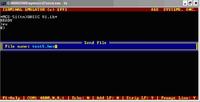
3rd step
=====
After pressing Enter I get this
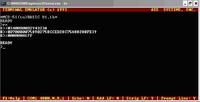
4th step
=====
I now write "call 7000h" and press enter to execute the program on my controller.
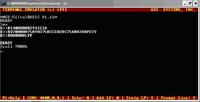
5th step
=====
Now the LED on port 1.4 is blinking at a very fast rate, I can detect it's blinking by my eyes.

This is the observation chart and number of times I repeat the above procedure.
No____Power Supply time (Turn off-Turn On)__Frequency Obtained on P1.4
1________N/A______56.2848 Hz
2________5s_______3.20 KHz
3________5s_______9.22 KHz
4________5s_______< 10 Hz
5________5s_______56.2848 Hz
6________5s_______9.22 KHz
7________5s_______56.2848 Hz
8________5s_______56.2848 Hz
9________5s_______9.22 KHz
10_______5s_______< 10 Hz
11_______10s______56.2848 Hz
12_______10s______56.2848 Hz
13_______10s______< 10 Hz
14_______10s______56.2848 Hz
15_______10s______9.22 kHz
16_______10s______< 10 Hz
17_______10s______56.2848 Hz
18_______10s______9.22 KHz
I turned ON and OFF my controller by removing and inserting the DC power adaptor into the power socket in this way, so as to remove content on RAM, just in case if the RESET button on controller board doesn't wash the RAM content.
TURN OFF
======

TURN ON
======

Added after 4 minutes:
NOTE:
====
Whenever a timer 0 interrupt is generated, the controller will jump to 000BH to read the code, this 000BH code resides in ROM, from there it jumps to 400BH to read the code, which resides in RAM address, so that a programmer can easily modify the code without having the need to program the UVROM one after the another during development process.
Program in this board are run on RAM. In this I have 256 KB of RAM, in which I’m starting my code at 7000h and will also run this program not from 0000h, but from 7000h.
Added after 5 hours 50 minutes:
The contact information given on this controller manual was:
Copyright 1998, Advanced Educational Systems
575 Anton Blvd. Suite 300, Costa Mesa, California 92626 USA
Tel: (714) 550-8094
Fax: (714) 550-9941
Today, I called on this telephone number, and a lady answered to me as no such company exists on this telephone number today(2007).This number was taken by some other business company.
I think the company has shut down and there's no help a customer can get from them
I am using AES-51 Computer Embedded Controller from ADVANCED EDUCATIONAL SYSTEMS for designing a project. It is based on 80C32 microcontroller.

Programs using interrupts are giving me unusual responses.
I made a test program which would generate a 10 KHz square wave on P1.4, now every time I run this program I get the different frequency on P1.4.
Test Program:
=========
org 400BH
TOISR:
cpl p1.4
reti
org 7000h
main:
mov tmod,#02h
mov th0,#-50
setb tr0
mov ie,#82h
sjmp $
end
I’m doing this as:
===========
• I attach RS-232 cable with a computer and attach the DC adaptor of controller in a power socket.
• I run the program and LED on P1.4 glows.
• I remove the DC adaptor of controller from the power socket for 5 sec or to 10 sec to ensure nothing remains in the RAM content.
• I plug again the DC adaptor right after 5 sec and download the program from my computer to this controller and run this program again. I see LED on P1.4 to glow.
• I check the frequency on P1.4. I have checked the frequency through 2 different multimeters and 1 oscilloscope and all measurements were the same, which proved that there was nothing wrong with instruments.
In computer:
========
I have this program for downloading my hex code into my controller.This program came along with this board on floppy disk,To do this I have to write RX and then press enter<CR>
1st step
=====

2nd step
=====
Now I press ALT+S to type the hex file name and then press ENTER.

3rd step
=====
After pressing Enter I get this

4th step
=====
I now write "call 7000h" and press enter to execute the program on my controller.

5th step
=====
Now the LED on port 1.4 is blinking at a very fast rate, I can detect it's blinking by my eyes.

This is the observation chart and number of times I repeat the above procedure.
No____Power Supply time (Turn off-Turn On)__Frequency Obtained on P1.4
1________N/A______56.2848 Hz
2________5s_______3.20 KHz
3________5s_______9.22 KHz
4________5s_______< 10 Hz
5________5s_______56.2848 Hz
6________5s_______9.22 KHz
7________5s_______56.2848 Hz
8________5s_______56.2848 Hz
9________5s_______9.22 KHz
10_______5s_______< 10 Hz
11_______10s______56.2848 Hz
12_______10s______56.2848 Hz
13_______10s______< 10 Hz
14_______10s______56.2848 Hz
15_______10s______9.22 kHz
16_______10s______< 10 Hz
17_______10s______56.2848 Hz
18_______10s______9.22 KHz
I turned ON and OFF my controller by removing and inserting the DC power adaptor into the power socket in this way, so as to remove content on RAM, just in case if the RESET button on controller board doesn't wash the RAM content.
TURN OFF
======

TURN ON
======

Added after 4 minutes:
NOTE:
====
Whenever a timer 0 interrupt is generated, the controller will jump to 000BH to read the code, this 000BH code resides in ROM, from there it jumps to 400BH to read the code, which resides in RAM address, so that a programmer can easily modify the code without having the need to program the UVROM one after the another during development process.
Program in this board are run on RAM. In this I have 256 KB of RAM, in which I’m starting my code at 7000h and will also run this program not from 0000h, but from 7000h.
Added after 5 hours 50 minutes:
The contact information given on this controller manual was:
Copyright 1998, Advanced Educational Systems
575 Anton Blvd. Suite 300, Costa Mesa, California 92626 USA
Tel: (714) 550-8094
Fax: (714) 550-9941
Today, I called on this telephone number, and a lady answered to me as no such company exists on this telephone number today(2007).This number was taken by some other business company.
I think the company has shut down and there's no help a customer can get from them



